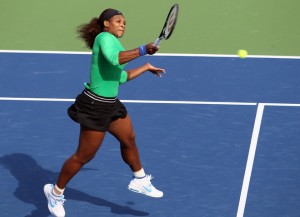When it came time for U.S. Open officials to either seed Serena Williams according to her ranking (No. 29) or bump her way up to the top three, my guess is there were some USTA executives who decided the last thing they needed was another 1996 nightmare.
Certainly, 1996 was a factor in the decision to just keep on seeding by the rankings.

If you weren’t following tennis then or were but have a short memory, it has been just about 15 years to the day that the USTA, Jay Snyder, who was then tournament director, and USTA President Les Snyder decided that the time had come for the U.S. Open to go Wimbledon and not strictly follow the rankings in the seeding.
The result was a pre-tournament uproar. The players cafeteria became the center for one angry meeting after another. French Open champion Yevgeny Kafelnikov, then ranked No. 4, had been reduced to a No. 7 seed and refused to play.
Fifteen Spaniards, including No. 16 ranked Felix Mantilla, who was refused one of the 16 seeds, threatened to leave New York en masse. Mark Miles, who was CEO of the ATP Tour, issued a strong rebuke to the Open: “This is OK for my country club tournament, but not a Grand Slam,” he said.
It didn’t help international relations that two U.S. players got improved seedings — Andre Agassi went from a No. 8 rank to No. 6 seed and Michael Chang, ranked third, was elevated to No. 2.
The player Chang exchanged with in the seeding, Thomas Muster, was livid.
Somehow, the Open went on with the subjective new seeding and the Spanish stayed when Mantilla was given a seeding to replace Kafelnikov, but surely no one at the Open forgot the mess that was created and they haven’t revisited the Wimbledon system since.
Re-seeding just one woman, Williams, is a lot different from a whole new seeding system, but would the WTA have objected? And would there have been a revolt from other women? Those are tough questions to answer right now and, besides, it’s moot because Serena is staying right where she belongs, at the No. 28 seed (she goes one place higher than her ranking because No. 3 Kim Clijsters is out with injury).
It’s too bad former director Snyder took so much heat, because he had a good case to re-seed players. Chang, who was moved up to No. 2, reached the final, where he lost to No. 1 Pete Sampras.
Kafelnikov, though he would in 1999 win the Australian Open and be runner-up the next year, had not in 1996 had a scintillating record on hardcourts. Mantilla, who was bumped out of the seedings altogether initially (there were only 16 seeds then), went out in the second round of the 1996 U.S. Open.
But the issue was more philosophic than logical. As several players pointed out, they spend all year on all surfaces getting their rankings up and, while seeding players by ranking isn’t perfect, it’s probably the most objective way to do it.
You could make a case that Serena Williams should be among the top four seeds, but if you start seeding players on the basis of their overall talent, then do you start taking into account their injuries? If Rafael Nadal, for example, misses 99 percent of the clay court season because of a knee injury and returns in time to play the French, which he has won multiple times, should his seeding be downgraded because he’s not in top form?
On the bottom line, it all becomes too subjective. Again, seeding by ranking is not perfect, but isn’t it the solution which is closest to perfection?
At No. 28, Serena will face the prospect of playing high-seeded players in early rounds, but so what? If she’s going to win the Open, she’s going to have to beat those players at some point. What does it matter, on the bottom line, whether it’s in the third round of the final?
